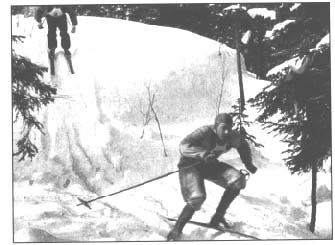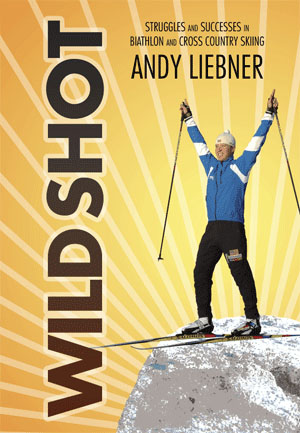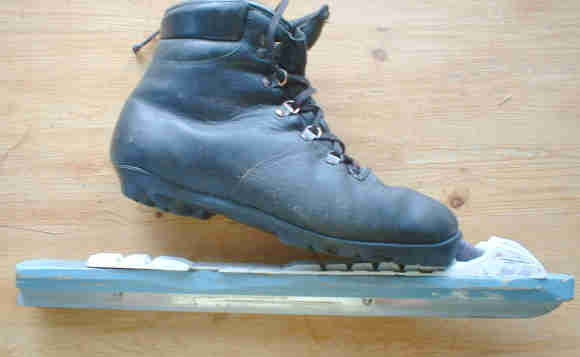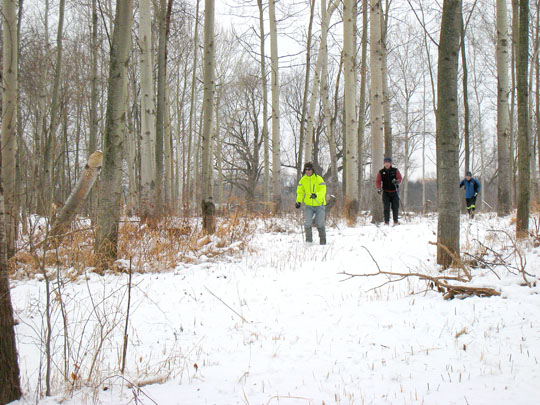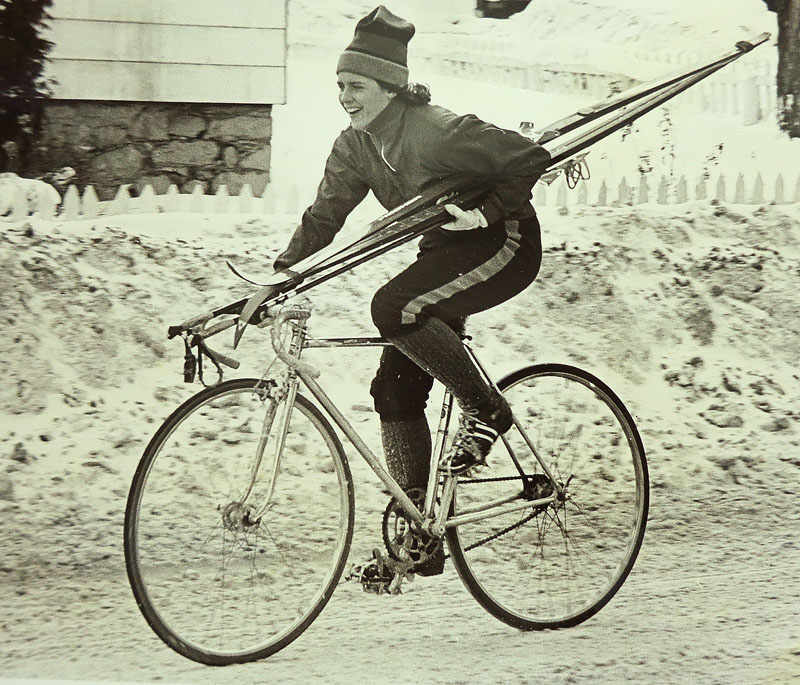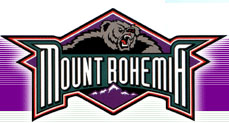[Reprint from 1/05]
Why would anyone like to do or watch XC skiing? What is it all about really? Where’s the attraction?
What’s the appeal of skiing in general? I submit with Coach Anikin that it’s about GLIDE. And to bring in the downhillers, I’ll add that it’s also about the rhythm of turning. But it’s mainly the glide. When you’re on something that is gliding, you smile. The goal then would be to maximize glide in as many places as possible, such as when going uphill or going on a trip. The rolling of a bicycle gives the same essential pleasure: the sense of getting something for nothing.
Just for fun let’s see how XC and Alpine skiing (and snowboarding) compare. Now, nothing in this essay is against alpine skiing per se. It’s great fun. But it has its limits.
XC skiing has 5 types of glide, plus plenty of turning. It has glide downhill, uphill, and thru the fields on the flats. It has skate glide, classic diagonal kick glide and puffy touring glide off the beaten path. It has the graceful and versatile telemark turn technique…in ADDITION to the alpine techniques! So, we’re talking more types of glide and more turns, too, than alpine! Altho some XC turns aren’t as potent as their alpine relatives, due to lack of monster skis and straightjacket boots.
Alpine wins on the pure rhythm-turns basis, but XC has a much wider scope.
XC is actually a lot like alpine except the trails are narrower. Alpine skiing uses the trail paradigm, but less so. Their trails might usually be better called freeways, and they only go one way, down. XC trails go absolutely everywhere, up down across and all around.
Where you XC ski is more natural, more like the real place you’re in, you often see more. The terrain is obviously less artificial than an alpine resort. A big XC trail system, or most any long trail, can expose you to more actual local cultural features than a condensed man-made alpine area.
Alpine skiing in lift-served resorts is a consumer product like an amusement park—but with more pollution, risk and expense. XC skiing comes from the grassroots. One is relatively superficial, the other is deep. What are these roots? Again, TRAILS. Trails become roads. Trails connect places. Trails cover terrain. This is what social geography and local culture are built on. You get a sense of participation and exploration while XC skiing. Scandanavian countries have XC trails connecting their towns like our nothern towns have snowmobile trails. (In fact, snowmobile trails make decent XC trails.)
Now, XC has its groomed resorts and Alpine can have heritage, but XC comes out ahead in the end.
The sensation of speed is greater in XC due to both narrowness of trail and lightness of equipment and thinness of XC clothing. With XC equipment and boots you have a sense of freedom due to its lightweight flexibility. Big XC downhills go 40mph, rivaling alpine SuperG speeds, but with more exposure.
Obviously, all speed is relative. The more intimate and exposed you are, the faster things seem to go. The more insulated you are, the more the feeling of speed is reduced.
With XC skiing, you’re always on. There’s no downtime on a chairlift and no sensation that what you’re doing is being overly supported by ungainly and actually unnecessary technology. XC skiers do everyting alpinists do, but without the lifts or limits. The billions of dollars which can be clearly seen at an alpine resort spent to help you only slide downhill can start to seem strange indeed to the observant.
XC trails are more like roller-coasters. They go up and down steeply and twist all around. It’s really fun to experience the feeling of compression at the bottom of hills, twists and dips, right before you go shooting uphill with lots of momentum. Alpine skiing has few dramatic vertical changes. Shifts of pitch create the thrill that expert alpinists search for, but they never have to deal with the extreme and diverse shifts that XC’ers deal with!
Now, XC has lots of speed and several different types of speed, also. This has to do with the need to smoothly manage momentum. A skier might be going uphill at 30 mph when coming out of a fast downhill, but to go smoothly over the top, he must flow every drop of big speed out of his momentum. This is easy enough to do when skilled. But this is also what gives XC its extra dose of grace, fluidity and dynamism. In alpine skiing, your is simply to turn without scrubbing too much downhill speed. That’s it. In XC, connecting all the dots to keep the speed rolling with a minimum of effort is at the root of its smooth and flowing dynamic style. It’s also what makes good skiers look so much nicer, better and effortless than others. It also creates the depth of skill needed and the need for endless learning to find and keep your own personal style.
In XC ski racing, there are often many skiers racing head to head at the same time, not side by side, but going for the same line!, duking it out and forming packs as in bike racing, going for breakaways, too. There’s a lot of room for team, group and individual strategies. What a mix! Also the differences in skills are more apparent and there’s more room for improvement, either in terms of more overall skill or in terms of immediate results. Successful strategy often pays off big. Results are hardly ever determined by start order. But a big public secret of alpine is that results are MOSTLY determined by start order, which is determined by previous heats. Every skier wrecks a course that much more. Alpinists are greedy for first tracks in both casual skiing and in races. This is not a worry in XC. The skier at the end of the day has as good of skiing as the one who starts.
XC events are diverse, both within an event and among the variety of events to choose from. Skill needs are more diverse, too, in a way. You get to glide uphill about half the time! (Fortunately, the uphill experience is at least as nice as the downhill. –But that would only be natural.) Then you have the flats thru the fields and meadows. In alpine skiing, there isn’t much fun in any fields. Alpine slalom and mogul skiers go about 5 mph. XC skiers on the flats go 20mph. So typical speeds are on par. But XC skiing is much more than that. XC is a 4-feature activity. Alpine is mainly about ski handling. XC is about skiing uphill, downhill, on the flats, and it’s about ski handling, too–with plenty of curves and turns thrown in. All these XC events are done on the same skis. As for variety of duration, in XC skiing you can easily go out for a weekend without crossing your old path once. Or you can enter races that range from sprints to ultramarathons. Lastly, you can do flat events or steeply hilly ones and everything between. All with world class quality levels if you like. Variety!
XC gives you at least four ways to ski on a typical day. You can skate, or classic stride—with its straight forward and back motion—or tour off the beaten path with motions more similar to snowshoeing, or do linked downhill ski turns, usually with the telemark turning technique.
XC skiing can be done almost anywhere. It can be done at most alpine resorts, but unlike an alpine resort, it can be done anywhere there is snow. No need for man-made imitation mountains. There are literally a million places in the US where people can do high quality XC skiing. World class XC skiing can usually be had much closer to home. Many areas only possess tiny alpine resorts while offering world class XC skiing terrain. It’s an easy sport to provide for, optimal in many geographies. This helps it to be PART OF more culture and geography.
XC skiing fits in with a healthy, muscular lifestyle and physique. Not too skinny, not too huge, not too fat: just right. And it has no typical injury likelihoods, few knee problems or stress fractures or broken limb risk. The lightness of the equipment allows for low-stress crashes. The need for skill keeps people more aware of their limits.
XC is much cheaper any way you want to do it, for fun or for racing.
Or, if you want to do it up, your buck goes lots farther. You could buy or rent top XC gear and stay at the best XC lodge and get 1st class everything plus trail passes for the same price of crappy alpine stuff and staying in a dumpy motel while eating at McD’s and skiing at a 3rd-rate downhill area. Get it? XC is the hot winter tourism tip!
The joyous glide of alpine skiing is broken up, with most of your time spent sitting and dangling. XC skiing allows one to experience nonstop glide even while going up fairly steep hills, in addition to everywhere else. This creates nonstop glide satisfaction that entices one to keep doing it and to keep improving. Here is the motivation to get the health benefit of XC, as well as the insight to see that hitting the trails is a good return on your effort!
